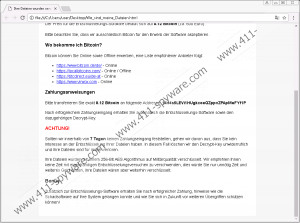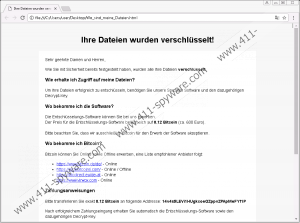Hsdfsdcrypt Ransomware Removal Guide
Hsdfsdcrypt Ransomware is a newly-detected ransomware infection whose target audience is German-speaking computer users. You should especially be cautious if you live in Germany, but, of course, users living in other countries cannot be careless too because this ransomware infection is primarily distributed via spam emails and, as a consequence, might reach all users. You are one of those curious users if you are reading this article, or you have already detected the ransomware infection on your computer. If it is the latter case, you should go to remove Hsdfsdcrypt Ransomware from your computer as soon as possible. This threat is not one of those ransomware infections that create a point of execution, i.e. it cannot start working automatically on system startup; however, you might still open its launcher accidentally again and, as a consequence, get more files encrypted. Yes, this German ransomware infection has also been programmed to lock users’ files upon the successful entrance. No doubt it does that so that cyber criminals behind it could easily obtain money from users. It is nothing new – numerous malicious applications developed these days act exactly the same.
Harmful malicious applications try to enter systems unnoticed, and Hsdfsdcrypt Ransomware is no exception; however, it is hard not to notice its successful entrance because it becomes impossible to access the majority of files, including pictures, documents, music, and more. Additionally, the ransom note Wo_sind_meine_Dateien.html is placed in directories with affected files. Users are told that they can no longer access their files because they “were encrypted with a military-grade 256-bit AES algorithm,” but specialists at 411-spyware.com say that it is not exactly true. Their research has shown that this ransomware infection corrupts users’ personal files instead of encrypting them. Because of this, it is very likely that “decryption software” and the “corresponding decrypt key” that can be purchased from cyber criminals for 0.12 Bitcoin (~ 960 USD) will be completely ineffective. That is, they might not unlock files for you. As a consequence, we do not think that it is a very good idea to transfer money to cyber criminals behind this ransomware infection. Sadly, there is only one way to get files back for free. Victims who back up their files periodically should be able to recover their files from the backup for free if they have it stored on a USB flash, a portable hard drive, or another device outside the compromised machine. If you are not one of them, you should remove Hsdfsdcrypt Ransomware and wait till free decryption software is developed. Sadly, we cannot promise that it will be released in the near future.
Hsdfsdcrypt Ransomware has already been detected on some computers, so specialists know how this infection is distributed. According to them, the biggest chance to encounter this threat is for those users who open spam emails because this infection is mainly spread via spam emails as an attachment. At first, it might seem that the attachment is a simple .pdf file, but the truth is that it has two extensions .pdf and .exe, for example, Viktoria Henschel - Bewerbung - November.pdf.exe. Because of this, the ransomware infection starts working the second this file is opened. It is one of the most popular methods to spread ransomware, but the chances are high that it is not the only one, specialists say, so users should not only ignore all spam emails they receive, but also be careful with software they download from the web and links they click. On top of that, our security specialists say that all users should enable a security application on their computers.
You will delete Hsdfsdcrypt Ransomware fully from your computer by killing its process via Task Manager and deleting the malicious file opened from your computer. Unfortunately, you could still not access your files after the removal of this malicious application. It does not mean that you can let it stay because you might launch it again accidentally one day and find more personal files locked. The easiest way to delete malicious software from the system is to perform a system scan with an automated antimalware tool, but if you have time to perform all the removal steps yourself, you can delete it manually too – we recommend consulting our removal guide.
Hsdfsdcrypt Ransomware removal guide
- Open Task Manager (tap Ctrl+Shift+Esc on your keyboard).
- Click Processes.
- Locate the malicious process of Hsdfsdcrypt Ransomware and kill it.
- Close Task Manager and press Win+E simultaneously to launch Explorer.
- Check %USERPROFILE%\Desktop, %USERPROFILE%\Downloads, and %TEMP% (you can open the directory by inserting its path in the Explorer’s URL bar and pressing Enter on your keyboard).
- Delete all suspicious files.
- Empty Recycle bin.
Hsdfsdcrypt Ransomware Screenshots:


Hsdfsdcrypt Ransomware technical info for manual removal:
Files Modified/Created on the system:
| # | File Name | File Size (Bytes) | File Hash |
|---|---|---|---|
| 1 | 085256b114079911b64f5826165f85a28a2a4ddc2ce0d935fa8545651ce5ab09.exe | 505344 bytes | MD5: 870acd0ca66986cc20ab0a655fbc5873 |
| 2 | Wo_sind_meine_Dateien.html | 23491 bytes | MD5: 7a96f66cbf8d9cf4728fec78aa0bbb4b |
Memory Processes Created:
| # | Process Name | Process Filename | Main module size |
|---|---|---|---|
| 1 | 085256b114079911b64f5826165f85a28a2a4ddc2ce0d935fa8545651ce5ab09.exe | 085256b114079911b64f5826165f85a28a2a4ddc2ce0d935fa8545651ce5ab09.exe | 505344 bytes |

